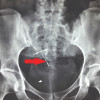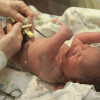
 IJCP Editorial Team
IJCP Editorial Team
Intralesional Sclerotherapy Cures Unusual Presentation of Hemangioma in a Child
Abstract
Hemangiomas are benign tumors made up of blood vessels. They usually regress spontaneously within 9 years of age. Hemangioma of retropharyngeal space is a rare entity. History, digital palpation, computed tomography (CT) and fine-needle aspiration cytology (FNAC) clinches the diagnosis. We want to report a case of retropharyngeal hemangioma in a 33-month-old female child who presented with respiratory distress. She was diagnosed and treated successfully in our department.
Case Report
A 33-month-old female child, presented with fever, cough and cold, who treated her symptomatically
She used to have frequent episodes of upper respiratory tract infection (URTI), when she got first attack of breathing difficulty during sleep. Her parents took her to Dept. of ENT, Ranchi Medical College, where she was admitted and stayed for 2 days. X-ray and computed tomography (CT) scan of nasopharynx revealed a retropharyngeal space occupying lesion (SOL) and they referred the case to a higher center.
Her parents complained that the child had sleepless nights for a fortnight because of the breathing difficulty she felt each time she desired to sleep. Only in prone position she got some relief from the distress, but unknowingly during sleep when her posture changed to supine she again felt the distress. On examination, her general condition was poor, her cry sounded a bit hoarse and she was very much apprehensive.
She was admitted and planned for examination of the SOL under general anesthesia.
In the operation theater (OT), digital palpation was done under general anesthesia. A cystic retropharyngeal mass was diagnosed. About 15 mL of altered blood from the cystic mass was aspirated (Fig. 3). Cytologic examination of that fluid showed RBC - 5.5 million/dL, WBC - 6,400/dL, platelets - 1,50,000/mL and no pus cells. She was kept under observation for 5-6 days and was discharged. She was readmitted in our department with the same complaints. Digital palpation and aspiration was done under general anesthesia. At this time 10 mL of fluid was aspirated followed by injection of sclerosing agent sodium tetradecyl sulfate (2 mL of the sclerosing agent was mixed with 4 mL of distilled water).
She was asked to come for follow-up 2-3 weeks later. For approximately 3 months she did well.
Discussion
The retropharyngeal space lies between the buccopharyngeal fascia covering posterior pharyngeal wall anteriorly and cervical vertebra with prevertebral muscles covered by prevertebral fascia posteriorly. This space is divided into two compartments (right and left) by its attachment with the median raphe. Types of retropharyngeal SOL: 1) Congenital (brachial cleft cyst, ectopic thyroid); 2) inflammatory (retropharyngeal abscess and retropharyngeal cellulitis); 3) neoplastic (cystic hygroma, neurofibroma, neuroblastoma, hemangioma); 4) traumatic (foreign body, hematoma) and 5) metabolic (hypothyroidism). Of them, the hemangioma is a rare cystic mass in this space, a benign tumor that grows within the blood vessels. Hemangiomas are the most common childhood tumors. A hemangioma (comes from the Latin words hemangio meaning blood vessel and oma meaning tumor with active cell dividing activity) is a benign self-involuting tumor of endothelial cells.
This tumor is most often found on the head or neck. However, they may occur anywhere on the skin or internal organs. It is usually found at 2-4 months of age. In most cases, hemangioma appears during the first days or weeks of life and resolves at the latest by age 10. Hemangiomas never develop in an adult. There is no reason now-a-days to accept that the only option available is to ‘leave it alone’ and wait for the hemangioma to ‘go away’ or allow it to attain mega size. Secondly, the most appropriate treatment plan needs to be individualized for each patient and each lesion. Therefore, similar lesions in different patients may be treated differently.1,2
Sclerotherapy is a procedure used to treat blood vessels or blood vessel malformations (vascular malformations) and also those of the lymphatic system. A medicine is injected into the vessels, which makes them shrink. It is used for children and young adults with vascular or lymphatic malformations. In adults, sclerotherapy is often used to treat varicose veins and hemorrhoids. Sclerosant is diluted with blood as it diffuses away from the site of injection, thus if a strong sclerosant is injected there will be three zones of action.
In zone 1, vascular endothelium is irreversibly injured: The vessel will be fully sclerosed and eventually will be completely replaced by a fibrous tissue. In zone 2, vascular endothelium is injured, and the vessel will be partially or completely thrombosed but will eventually recanalize. In zone 3, the sclerosant will be diluted below its injurious concentration, and there will be no endothelial injury. Sclerosants are polidocanol, 5% phenol, absolute alcohol, hot water, hypertonic saline and sodium teradecyl sulfate.3 In our case, we unanimously thought that sclerotherapy would be the best treatment option and accordingly we did it. We used sodium tetradecyl sulfate as sclerosant. Being a detergent-based chemical, its action is on the lipid molecules in the cells of the vein wall, causing destruction of the internal lining of the vein and causing them to shed, leading to thrombosis, fibrosis and obliteration (sclerosis). It is used in concentrations ranging from 0.1% to 3% for this purpose. Till now, the patient is relieved of the distress with this treatment (one and half years follow-up) and we expect no recurrence in future. There are various types of treatment protocol like sclerotherapy, laser, interferon α2, intralesional corticosteroid therapy,3-6 but we used sclerotherapy with successful result without any complication.
Conclusion
Hemangioma of retropharyngeal space is a rare entity. CT scan followed by digital palpation and fine-needle aspiration cytology (FNAC) can clinch the diagnosis in case of retropharyngeal hemangiomas, which present with respiratory distress. Repeated aspiration of collected fluid and sclerotherapy in hemangiomas is a preferable treatment option.
References
- Fishman SJ, Mulliken JB. Hemangiomas and vascular malformations of infancy and childhood. Pediatr Clin North Am. 1993;40(6):1177-200.
- McCook TA, Felman AH. Retropharyngeal masses in infants and young children. Am J Dis Child. 1979;133(1): 41-3.
- Woods JE. Extended use of sodium tetradecyl sulfate in treatment of hemangiomas and other related conditions. Plast Reconstr Surg. 1987;79(4):542-9.
- Landthaler M, Hohenleutner U, el-Raheem TA. Laser therapy of childhood haemangiomas. Br J Dermatol. 1995;133(2):275-81.
- Gawrych E, Walecka A, Rajewska J, Juszkiewicz P. Intralesional corticosteroid therapy in infantile hemangiomas. Ann Acad Med Stetin. 2009;55(1):15-21.
- Ezekowitz RA, Mulliken JB, Folkman J. Interferon alfa- 2a therapy for life-threatening hemangiomas of infancy. N Engl J Med. 1992;326(22):1456-63.

IJCP Editorial Team
Comprising seasoned professionals and experts from the medical field, the IJCP editorial team is dedicated to delivering timely and accurate content and thriving to provide attention-grabbing information for the readers. What sets them apart are their diverse expertise, spanning academia, research, and clinical practice, and their dedication to upholding the highest standards of quality and integrity. With a wealth of experience and a commitment to excellence, the IJCP editorial team strives to provide valuable perspectives, the latest trends, and in-depth analyses across various medical domains, all in a way that keeps you interested and engaged.













Please login to comment on this article